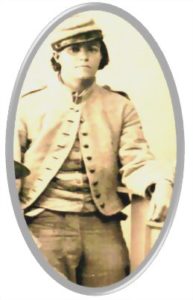
Historians are a bit like detectives. They sift through evidence, weigh it, and try to leave no stone unturned.
But when they publish their results, they’re a bit like lawyers. They need to be objective enough to gain the credibility of the judge and jury, but they are still advocating. They back up their historical observations with evidence and try to draw new conclusions.
In the following guest blog, historian Shelby Harriel uses the same analogy as a springboard into her research into women Civil War soldiers. Those female warriors were actually committing a crime. They also violated the norms of Victorian society. Because of that they covered their tracks and concealed their true identities. Sometimes the army even destroyed the evidence if they were caught.
That makes women Civil War soldiers hard to research. But their contributions to the war were invaluable; the research adds a new layer of understanding to Civil War history. Shelby Harriel is writing a book on women Civil War soldiers. I met her online, through her fascinating blog, Forbidden, Hidden, and Forgotten: Women Soldiers of the Civil War, and invited her to write a guest blog. You can read more about Shelby and her book below.
Here’s Shelby Harriel with her guest blog:

I was delighted to meet Ann Marie recently. As bloggers, researchers, and writers, we share similar experiences. We also share a love of history. So I was extremely honored when she asked me to contribute a guest post. Beyond the aesthetically pleasing nature of her blog, Ann Marie has some very interesting content among her writings, most of it dealing with true crime. It made me think of how I, as a historian, am like a detective in my search for women soldiers of the American Civil War, 1861-1865.
The Suspects
Hundreds, perhaps thousands, of women disguised themselves as men and fought in the Civil War. We’ll never know exactly how many there were.
The Crime
Victorian society was strictly defined. Women were supposed to be passive and remain in the domestic sphere. They were expected to create life, not take it. Therefore, the government did not allow Victorian women to serve in the military. War was the domain of men.
Clothing defined the genders. Women did not wear pants. Doing so resulted in imprisonment and/or a fine, not to mention the shame that discovery would bring themselves and their family.
So when women traded in their hoop skirts for army trousers, not only did they defy the morals and mores of the times, which was unacceptable behavior, they were also breaking the law.
It is difficult to think of these women Civil War soldiers as criminals, especially since many of them made the ultimate sacrifice and lie buried in graves right next to the men with whom they served. But, by definition, women soldiers were committing a crime. (And so were the hundreds of thousands of boys under 18 years old who lied about their age in order to fight.)
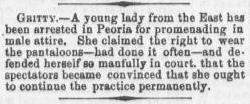
The Crime Scene
Women are reported to have fought in every major battle of the American Civil War. They were there from the beginning to the end.
The Motives of Women Civil War Soldiers
Why would these women risk their reputation and lives for a society that did not desire their service? There were several reasons. A majority of them enlisted in order to avoid being separated from a loved one. Others were trying to escape an oppressive situation. Economic factors drove some women. Disguised as men working in masculine-only professions, they could make more money than they ever could in the few jobs available to Victorian women. Patriotism motivated some women to enlist while others were simply seeking adventure, not unlike their male counterparts. Love, fear, money, duty…motives common to any good mystery story.
The Witnesses
Civilians, common soldiers, high-ranking officers, and even well-known generals bore witness to women serving in the military during the Civil War.
The Evidence
Documentation is the backbone of any historian’s arguments. The same goes for a criminal investigator. Without supporting evidence, there is no case. And sometimes, acquiring this evidence and documentation is challenging. Just like investigators of a criminal case, researchers who delve into the topic of women Civil War soldiers must overcome the obstacle of subterfuge. In order to serve in the military, these women had to disguise themselves. They cut their hair short, wore clothes that Victorians weren’t accustomed to seeing them wear, and assumed an alias. (Some men did this, too….enlisted under an alias that is.) When discovered, some women soldiers not only told newspaper reporters the wrong male aliases they used, but they sometimes provided a false feminine name, if any at all. Remember, it wasn’t that difficult for Victorians to assume a new identity. They didn’t have birth certificates or forms of identification.
How does one find an individual who doesn’t want to be found?
Chasing phantom identities
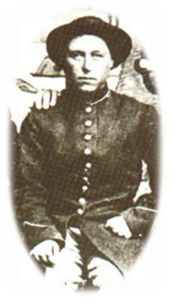
Secondary sources
Before anyone may choose to venture into this realm themselves, I would suggest purchasing a box of hair color to hide the gray hair that will be infesting your head. Eat chocolate. And develop an exercise regimen to relieve the stress. Eat more chocolate and understand that you’re not going to find all of the answers.
A good place to start an investigation is to read secondary sources. But proceed with caution. Both period and contemporary accounts may contain errors. Some researchers can be careless. On the other hand, it may not necessarily be the fault of the authors. Most historians do the best they can with the evidence available to them at the time. It is the job of subsequent generations of researchers to uncover new findings and advance the historical narrative. And this is why it’s important to instill the love of history in young people. As archives continue to digitize more records, the more information people from all over the world will have access to. This is exciting!
Genealogy
After scouring secondary sources for names, dates, regiments, etc., I enter the information in a genealogy website to see if I can discover the true name of the woman soldier, attempt to complete her story by finding out what happened to her after the war, or determine whether she existed at all.
Newspaper archives
I also like to search newspaper archives for period articles. Again, the information may be wrong. Names were sometimes spelled phonetically, and an incorrect unit may have been mistakenly recorded. Furthermore, the woman soldier may have chosen to lead the reporter astray in order to protect the reputation of herself and her family. Or the reporter may have chosen to take an otherwise true story and embellish it with exciting….and incorrect….details. And some newspaper editors simply made up the story entirely. They were trying to make a living by selling newspapers, after all. I try to collect as many articles as I can about an individual woman soldier. Even though all of them may contain the same basic information, one unique sentence in a single article can make the difference in piecing together the true story.
Primary sources
All investigators question the witnesses… or they’re supposed to. Since all of the individuals involved in my realm of research have all passed on, it is necessary to acquire their testimony by investigating their letters and diaries. I always feel as if I’m being rude by invading someone’s personal space, but at the end of the day, they’re not around to protest. And these primary sources provide a wealth of all sorts of interesting information. Again, one must proceed with caution. Soldiers sometimes merely reported camp rumors and were not personally privy to the events they were writing about. On the other hand, I have discovered information in a letter or diary that validated a newspaper article or was a completely new find. One thing is for sure. These missives are not tainted with political correctness! Other primary sources such as regimental histories, prison records, court martial transcriptions, and provost marshal documents also provide invaluable information. Some of these particular records that I have examined have supported the claims of some women Civil War soldiers while debunking others.
Service records
Service records are the gold mine of military records. One can learn all sorts of information from them: when and where a soldier enlisted, a physical description, an antebellum occupation, when and where the soldier was mustered out, any prison records, some medical records, and any duty the soldier was assigned to. To a lot of people, service records are the smoking gun. According to some, if none can be found, this is enough to disprove a woman soldier’s service. “If they don’t exist, you must omit!” Ah, but a prosecutor doesn’t need the murder weapon or even a body to get a conviction. In the case of women Civil War soldiers, a lack of service records does not necessarily equate to a lack of service. For example, there is an account of a woman killed by an exploding shell during a particular battle. The story is supported by a future president of the United States, his future brother-in-law, who was a surgeon standing next to the soldier when she was killed, and several private soldiers who recorded the event in diaries and letters. The surgeon provided enough details to narrow down a possible unit that the soldier belonged to. So off I went to search for her service records. Two months later, my aching eyes and I were unable to locate any. Nor have I been unable to find any newspaper articles about the event. Yet it happened.
Medical records
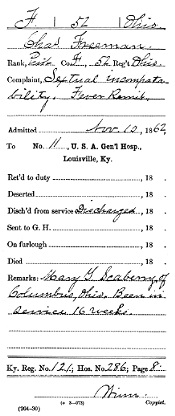
Here’s another example. Enter Exhibit A, carded medical record and discharge document for Mary Scaberry, alias “Charles Freeman,” of the 52nd Ohio Infantry. Obviously, she served….until she went into the hospital with a fever and ultimately discharged for “sextual incompatibility” after her true identity was discovered. In addition to this card, newspaper articles document her story as well. But yet there are no service records for her. Nor does she appear on the unit’s roster. So what happened to her records? It could be that they were inadvertently lost or destroyed over time. Or officials could have deliberately expunged them. Officers were often embarrassed and angry when a woman was discovered in their unit. They had just been fooled after all. Also, if a woman was hired as an officer’s servant or orderly, there wouldn’t be any service records because she wouldn’t have been mustered in. Yet she would have worn a uniform and experienced the same trials with the rest of the members of the regiment.
As for Scaberry, just like her service records, her ultimate fate also remains a mystery at this time. After she was discharged, she went home to Columbus, Ohio, only to be spurned by her father. Seeking employment, she then made her way to Chicago where she encountered a guard at Camp Douglas who made fun of her. She promptly beat him up which landed her in police court. The judge felt sorry for her and released her. She then vanished from history, rendering the tale of her life incomplete.
Women Civil War Soldiers: Tough Cases to Prove, But Valuable Contributions to History
As we have seen, researching women Civil War soldiers is much like any courtroom drama in film or text. The evidence is gathered, crime scene investigated, witnesses interviewed, and trials held. However, unlike most crime stories, there is no dramatic final scene….no dramatic presentation of the final piece of evidence to deliver the coup de grace as it were. But just as in these crime stories, the process of bringing the truth to light is the ultimate goal. However, there is no jury to decide the fate of these women. It is up to all of us to help solve this century old “crime.” The book never closes on a murder and it is my hope that the book will never close on the gallant and mostly unknown deeds of these courageous women.
Thank you, Shelby!
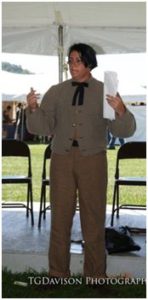
About Shelby Harriel:
Shelby Harriel received her B.A. in History with a minor in mathematics in May 1997 and her M.Ed. with an emphasis in mathematics and history in 2005. She earned both degrees from the University of Southern Mississippi. Shelby has been teaching mathematics at Pearl River Community College since 2007.
While her career has always revolved around mathematics, Shelby actively pursues her passion for history through research, exchanging ideas, and speaking to the public. For her efforts, Pearl River Community College bestowed upon her the Outstanding Humanities Instructor award in 2014. She is also a member of the speaker bureau of the Mississippi Humanities Council.
Papers/Articles
“The Third Mississippi Infantry and Hancock County”
“A Different Look at the Yankee Invaders: Two Women Disguised as Male Soldiers in Louisiana”
“A ‘Hole’ New Perspective: A Woman Soldier at the Crater”
“Bully For Her: Women Who Served Openly as Women”
Shelby is currently writing a book on women soldiers of the Civil War, Forbidden, Hidden, and Forgotten: Women Soldiers of the Civil War.
You can follow Shelby on Facebook too, where you’ll receive updates about her book.

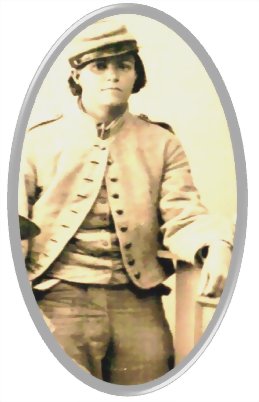



I do not have a comment, but would like your contact information, as I would like to invite you to speak at the Jackson Civil War Round Table in either April or May, if you are interested.
I’ll send you an Email, Joyce. Please check your inbox.
Shelby Harriel, well done!